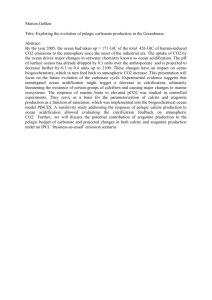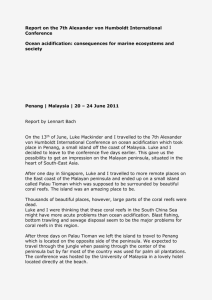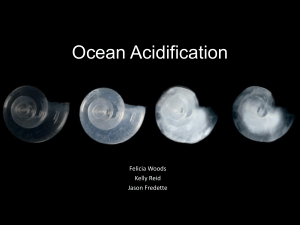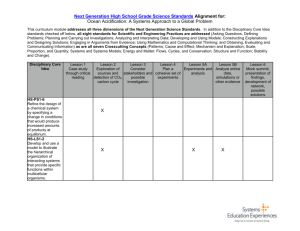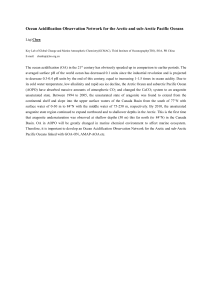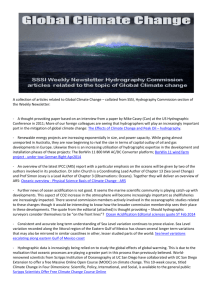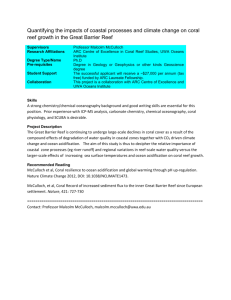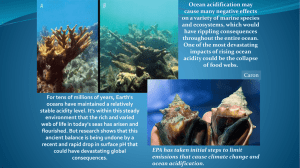Federal Register: April 15, 2009 (Volume 74, Number 71)
advertisement
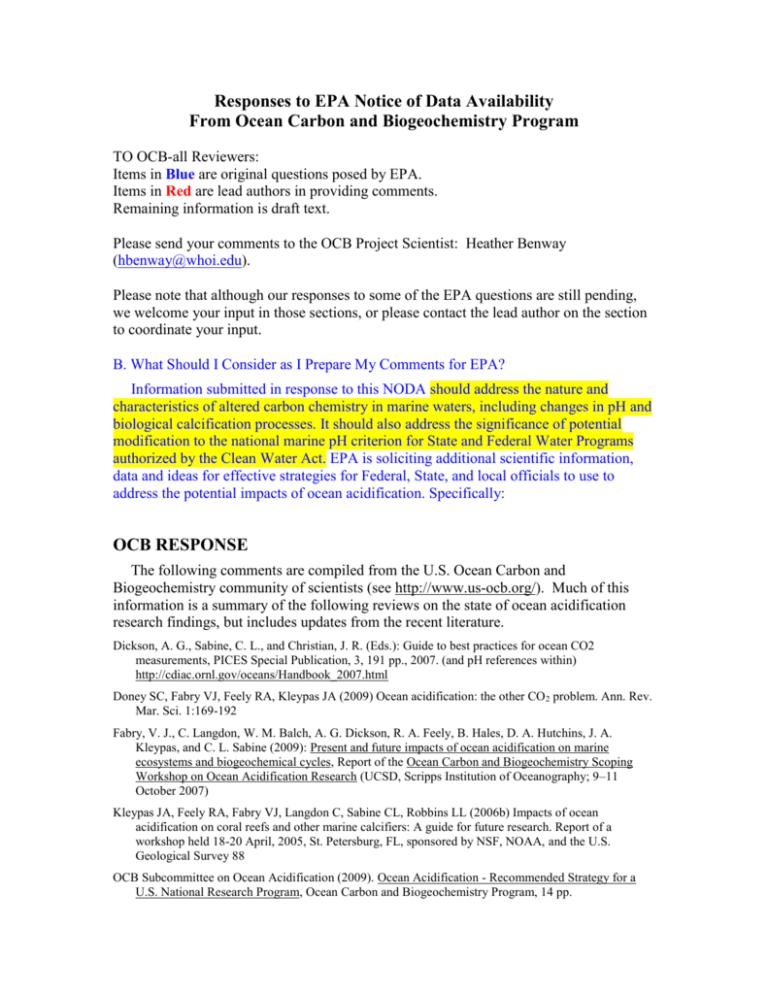
Responses to EPA Notice of Data Availability From Ocean Carbon and Biogeochemistry Program TO OCB-all Reviewers: Items in Blue are original questions posed by EPA. Items in Red are lead authors in providing comments. Remaining information is draft text. Please send your comments to the OCB Project Scientist: Heather Benway (hbenway@whoi.edu). Please note that although our responses to some of the EPA questions are still pending, we welcome your input in those sections, or please contact the lead author on the section to coordinate your input. B. What Should I Consider as I Prepare My Comments for EPA? Information submitted in response to this NODA should address the nature and characteristics of altered carbon chemistry in marine waters, including changes in pH and biological calcification processes. It should also address the significance of potential modification to the national marine pH criterion for State and Federal Water Programs authorized by the Clean Water Act. EPA is soliciting additional scientific information, data and ideas for effective strategies for Federal, State, and local officials to use to address the potential impacts of ocean acidification. Specifically: OCB RESPONSE The following comments are compiled from the U.S. Ocean Carbon and Biogeochemistry community of scientists (see http://www.us-ocb.org/). Much of this information is a summary of the following reviews on the state of ocean acidification research findings, but includes updates from the recent literature. Dickson, A. G., Sabine, C. L., and Christian, J. R. (Eds.): Guide to best practices for ocean CO2 measurements, PICES Special Publication, 3, 191 pp., 2007. (and pH references within) http://cdiac.ornl.gov/oceans/Handbook_2007.html Doney SC, Fabry VJ, Feely RA, Kleypas JA (2009) Ocean acidification: the other CO 2 problem. Ann. Rev. Mar. Sci. 1:169-192 Fabry, V. J., C. Langdon, W. M. Balch, A. G. Dickson, R. A. Feely, B. Hales, D. A. Hutchins, J. A. Kleypas, and C. L. Sabine (2009): Present and future impacts of ocean acidification on marine ecosystems and biogeochemical cycles, Report of the Ocean Carbon and Biogeochemistry Scoping Workshop on Ocean Acidification Research (UCSD, Scripps Institution of Oceanography; 9–11 October 2007) Kleypas JA, Feely RA, Fabry VJ, Langdon C, Sabine CL, Robbins LL (2006b) Impacts of ocean acidification on coral reefs and other marine calcifiers: A guide for future research. Report of a workshop held 18-20 April, 2005, St. Petersburg, FL, sponsored by NSF, NOAA, and the U.S. Geological Survey 88 OCB Subcommittee on Ocean Acidification (2009). Ocean Acidification - Recommended Strategy for a U.S. National Research Program, Ocean Carbon and Biogeochemistry Program, 14 pp. It should be noted that major recommendations in these reviews are to improve and increase monitoring of ocean acidification, including in the coastal zone, and to increase research on its impacts on marine organisms and ecosystems. We have addressed the EPA questions in the order that they were proposed in the NODA. 1. [DICK FEELY] EPA is soliciting technical information on measurement of ocean acidification in marine coastal waters, including: a. Technological advances in rapid, continuous, or remote measurement of pH; Currently, the standard techniques associated with detection of ocean acidification involve measurements of two or more parameters of the CO2 system in seawater, along with measurements of temperature, salinity, oxygen, and nutrients. CO2 partial pressure (pCO2), pH, total alkalinity (TA or AT), dissolved inorganic carbon (DIC or CT), dissolved organic carbon (DOC) can be measured with very high accuracy and precision onboard oceanographic ships. The methods are well established and described in great detail in the “Guide to Best Practices for Ocean CO2 Measurements” (Dickson et al., 2007). In addition, appropriate standards are available for CT, AT and pCO2. For ocean acidification research at least two, and preferably three, of the four carbon parameters should be measured at each of the sampling depths to ensure internal consistency of the data sets (Table 1). Accuracy and precision can be obtained from replicate measurement of certified standards (Table 1). While some of these chemical species can now be measured on moorings they are not yet broadly utilized on a global scale. Moreover, new method development is required for routine measurements of DIC and TA and proxies that may indicate stress on biological organisms. Table 1. Present status (2007) of certified reference materials for the quality control of oceanic carbon dioxide measurements (modified after Dickson et al., 2007). Analytical Measurement CT Total dissolved inorganic carbon Desired Accuracya and Certification ± 1 µmol kg–1 certification: since 1991 Methodology References coulometric: All carbonate species are converted to CO2 gas by acidification of the seawater sample. The evolved CO2 gas is carried into the titration cell of the coulometer, where it reacts with a colorimetric reagent. Absorption of CO2 stimulates the hydrolytic production of hydroxide ions (OH-), which stoichiometrically titrates the colorimetric acid. CO2 is thus measured by integrating the total coulometric OH- production required to achieve full titration. precision and accuracy: ± 0.05% in laboratory setting Johnson et al. 1985, 1987 AT Total alkalinity ± 1 µmol kg–1 certification: since 1996b pH ± 0.002 certification: –c ƒ(CO2) ± 0.5 µatm certification: –d potentiometric titration: A measured amount of acid titrant is added to the sample to reduce the pH to less than 3.55, CO2-free air is bubbled through the acidified sample to facilitate removal of the evolved CO2 gas, followed by titration to a pH of less than 3.0. The titration curve is fit to a derivation of the seawater alkalinity equation using a non-linear least squares approach that takes into account the various acid-base equilibria in solution during the titration. precision and accuracy ± 0.1% in laboratory setting spectrophotometric: A pH indicator calibrated on the total hydrogen ion concentration scale5. Absorbance ratios are measured at 578 and 434 nm against a reference solution of pure seawater, and absorbance at a nonabsorbing wavelength is used to correct for small absorbance variations attributable to manipulations of the 10-cm cylindrical cuvette. precision and accuracy: 0.002 pH units under field conditions A known amount of seawater is isolated in a closed system containing a small known volume of air (containing a known initial amount of carbon dioxide) and maintained at a constant, known temperature and pressure. Once the water and air are in equilibrium a sample of the air is analyzed for carbon dioxide content using a gas chromatograph or infrared CO2 detector which is capable of integrating a constant volume of CO2 Dickson et al. 2003 Clayton and Byrne, 1993 Chipman et al., 1990 Wanninkhof and Thoning, 1993 a Based on considerations outlined in the report of SCOR Working Group 75 (SCOR 1985). They reflect the desire to measure changes in the CO2 content of sea water that allow the increases due to the burning of fossil fuels to be observed. b Representative samples of earlier batches were also certified for alkalinity at that time. c The pH of a reference material can be calculated form the measurements of total dissolved inorganic carbon and total alkalinity. Also, buffer solutions based on TRIS in synthetic sea water can be certified for pH, but as yet this is not done regularly. d CO2 in air reference materials are presently available through a variety of sources. However, it is desirable to use a sterilized sea water sample as a reference material for a discrete ƒ(CO 2) measurement. Although the thermodynamics of the sea water system suggest that, since the CRMs are certified stable for CT, AT, and pH, they should be stable for ƒ(CO2), a reliable technique for independently determining ƒ(CO2) to allow proper certification has not yet been developed. b. Long-term empirical pH data and carbon chemistry measurements, especially those that may demonstrate ocean acidification; EPA is directed/encouraged to seek out long-term coastal States’ and Federal datasets (e.g., USGS, NOAA) on water quality or any monitoring studies that have included pH data collected in coastal State waters. These datasets often have been collected as ancillary data for long- term water quality monitoring (e.g., in conjunction with E. coli monitoring) but may be available for other monitoring studies as well. Technically, pH data collected within coastal environments in the U.S. for the past 4-5 decades may not be optimal in resolution and accuracy; however, they will provide EPA invaluable information on long-term trends and seasonal and yearly variability of pH that the coastal environments are likely to demonstrate. Rigorous statistical evaluation of the data must be applied but often these datasets are so robust that lack of data is not an issue for statistical analyses. c. Empirical data to demonstrate spatial and temporal variability of pH in near-coastal waters; (pending) d. Methods to statistically evaluate variability of pH in near-coastal waters; (pending) e. Other approaches (e.g., carbon chemistry), methods and indicators that could reflect ocean acidification. (pending) 2. EPA is soliciting technical information on effects of ocean acidification on marine biota, including: a. [KLEYPAS/LANGDON] Survival, growth, reproduction, and recruitment of reef-building corals and crustose coralline algae; Our response addresses coral and coralline algae separately: CORALS Survival. No studies to date have shown that a lowering of seawater pH alone (at least within the range of surface ocean pH values expected for this century) will directly affect coral survival rates. Polyps of two species of corals (Oculina patagonica and Madracis pharencis) tripled their biomass in waters with pH values of 7.3-7.6, although the skeletons of these corals had completely dissolved leaving the coral polyps with an anemone-like existence (Fine, Tchernov 2007). Net organic production in coral communities does not seem to increase under elevated CO2 conditions (Langdon et al. 2003). Indirect effects of ocean acidification on reef corals may threaten their survival more than direct effects, these include: o Slower calcification rates. Several studies suggest that coral survival will be indirectly impacted by ocean acidification because of its effects on skeletal growth. In the extreme example above, the vulnerability of “naked” corals to predation and physical damage in a natural reef environment would be greatly increased. It is unlikely that ocean pH will be lowered to levels that will lead to complete decalcification of corals. However, several reviews (Kleypas et al. 2006b; Kleypas, Langdon 2006) list multiple ways that reduced skeletal growth may impact coral survival rates, because it may: 1) decrease a coral’s ability to compete for space, 2) decrease its ability to withstand hydrodynamic and erosional forces, 3) delay its age of sexual maturity, 4) increase the rate of fragmentation and thus in some corals, the rate of asexual propagation, 5) alter the skeletal light-gathering properties for photosynthesis, and 6) alter gamete production and larval development (although see below), or larval recruitment. While many of these hypothesized impacts seem logical (for example, calcifying organisms disappeared with proximity to a natural CO2 vent on a shallow sea floor; (Hall-Spencer et al. 2008)) it should be noted that most have not yet been explicitly tested. o Increased sensitivity to temperature. In concert with rising ocean temperatures, ocean acidification may have an additional impact on coral survival rates, as it has been shown to be a factor in coral bleaching. The bleaching temperature threshold was lower in corals (Acropora intermedia and Porites lobata) when pH was decreased to levels expected this century (Anthony et al. 2008). o Increased bioerosion rates. Bioerosion rates of coral skeletons by euendolithic algae increases significantly with decreasing pH (Tribollet et al. in press). Low inorganic cementation rates and high bioerosion rates have been documented in naturally low pH regions such as the Galapagos Islands, but it is not clear whether low pH is the main factor controlling these rates amongst other factors such as temperature and nutrient concentration. o Loss of habitat. Coral survival may eventually be impacted if coral reef structures move from a state of construction to destruction, as is predicted to occur this century (Silverman et al. 2009). The habitat loss associated with a shift in the balance of hard ground to sediment ratios, loss of reef structural complexity, and a decrease in habitat diversity may have an impact on survivorship of certain species. Growth - Decreased skeletal growth in reef-building corals is now a well-documented consequence of ocean acidification (see reviews: (Kleypas et al. 2006a; Doney et al. 2009)). A wide range of responses has been observed, but on average, a doubling of preindustrial atmospheric CO2 values results in about a 10-50% decrease in calcification rates of reef-building corals. (Langdon, Atkinson 2005) found that in the suite of experimental data on corals and coral communities through 2006, a doubling of atmospheric CO2 concentration produced two clusters of responses: a 40-83% reduction in calcification or a 1-8% reduction. They attributed this dichotomy to differences in sensitivity across species and/or differences in experimental setup. The response is reversible (calcification will increase if pH is increased). There is no evidence yet that coral calcification can adapt to these changes. It is not yet clear whether calcification rates of non-reef building corals are equally impacted. - Most studies have been conducted in the lab, under non-varying conditions, but the results are consistent with recent studies that allowed the control and simulated future pH conditions to vary naturally (Jokiel et al. 2008; Kuffner et al. 2008). This is important because coral reefs waters can naturally exhibit large diurnal swings in pH (e.g. 7.9-8.1, (Bates et al. 2001; Suzuki, Kawahata 2003)), and it was unclear whether the added suppression of pH by 0.1-0.3 pH units projected for this century would have a significant effect. Reproduction and Recruitment The effects of ocean acidification on coral recruitment encompass responses in gamete production, fertilization rates, planula larvae, larval settlement, and post-settlement growth. There are very few data on any of these aspects. A brief summary of observations are listed below: - (Jokiel et al. 2008)showed that Montipora capitata was able to produce gametes under conditions consistent with a doubling of today’s atmospheric CO2 levels. The same study illustrated that larvae of Pocillopora damicornis were able to recruit under the doubled CO2 conditions. - (Albright et al. 2008) studied larval settlement and post-settlement growth in Porites astreoides cultured under seawater conditions with pCO2 levels of 380 ppm, 560 ppm, and 720 ppm. The percent or larval settlement did not differ between treatments, but relative to the 380 ppm treatment, post-settlement growth (skeletal extension rate) was decreased by 50% and 78% in the 560 and 720 ppm treatments, respectively. (Albright et al. 2008) also noted that success in coral recruitment, metamorphosis and growth depends on substrate characteristics, and particularly with microbial biofilms and crustose coralline algae (Heyward, Negri 1999; Negri et al. 2001; Webster et al. 2004; Williams et al. 2008). Reef-building CCA have been shown to be quite sensitive to ocean acidification (see (Kuffner et al. 2008) and (Anthony et al. 2008) below). In addition to CCA, the articulated coralline algal genus Amphiroa is known to induce settlement of bivalve larvae (Williams et al. 2008), and is also considered sensitive to ocean acidification as evidenced in the overall community response to ocean acidification in the Biosphere 2 coral reef experiments (Langdon et al. 2000). Thus the effects of ocean acidification on coralline algae may affect the recruitment of corals and perhaps other organisms such as bivalves. CRUSTOSE CORALLINE ALGAE (CCA) Survival CCA are distributed worldwide from the tropics to the polar seas, and are some the deepest living photosynthetic organisms in the ocean. Almost all secrete skeletons of high-Mg calcite, which, depending on the Mg content, is a particularly soluble form of calcium carbonate that is typically more soluble than aragonite. Latitudinal variation in CCA mineralogy and ecology is high, so the response of CCA to ocean acidification is likely to vary considerably within this group. Tropical reef-building CCA, however, appear to show a consistent decrease in both production and calcification in response to ocean acidification. o Increased sensitivity to temperature. Similar to the effect of ocean acidification on coral bleaching (described above), the coralline algae Porolithon onkodes showed a loss of pigmentation that was increasingly sensitive to warming at decreasing pH (Anthony et al. 2008). A similar effect was observed in Lithophyllum cabiochae (Martin, Gattuso 2009). o Field observations. The abundance of coralline algae decreases rapidly with proximity to a shallow submarine CO2 vent, which suggests that coralline algae could not survive in the low pH waters near the vent (in pH < 7.7, (Martin et al. 2008), (Hall-Spencer et al. 2008). Temperature-induced mortality of the temperate CCA L. cabiochae was 2-3 times greater when pCO2 was elevated from 400 ppm to 700 ppm. Growth o Productivity. One study has examined the effects of pH on daily net production (photosynthesis minus respiration) of the common reef-building algae P. onkodes (Anthony et al. 2008). Relative to net production at normal pH (8.0-8.4), net production at pH levels of 7.85-7.95 and 7.6-7.7 was decreased by 50% and 100%, respectively. o Slower calcification rates and higher skeletal dissolution rates. CCA may be more sensitive to ocean acidification continues, because of the greater solubility of their high-Mg calcite skeletons, but well controlled studies of the effects of ocean acidification on CCA growth have only recently been conducted. Rhodolith calcification rates decreased 250% (net dissolution) in mesocosms with CO2 levels elevated by 365 ppm over present day conditions (Jokiel et al. 2008; Kuffner et al. 2008). The surface area of CCA was also reduced from 25 to 4% in the CO2-enriched conditions. (Anthony et al. 2008)showed that calcification rates in P. onkodes decreased by 50% when pH was decreases from 8.0-8.4 to 7.85-7.95, and by 130-190% (indicating net dissolution) when pH was decreased further to 7.6-7.7; an increase in temperature had no significant effect. Conversely, (Martin, Gattuso 2009) found that calcification rate of the temperate coralline alga L. cabiochae increased by 30% under elevated CO2 alone (700 ppm versus 400 ppm conditions), but decreased by 10% if temperature was also elevated from 22 to 25ºC. The latter study suggested that L. cabiochae might have the capacity to acclimate or adapt to higher pCO2 levels; but also found that net dissolution of L. cabiochae skeletons was 2-4 times higher in the 700 ppm versus 400 ppm conditions (Martin, Gattuso 2009). Reproduction and Recruitment - The response of CCA reproduction to ocean acidification has not been explicitly investigated. However, (Kuffner et al. 2008)found that CCA recruitment rates in acidified conditions (365 ppm CO2 higher than untreated conditions) were reduced by 72%. b. [KLEYPAS/LANGDON] Anticipated persistence of coral reef communities under future pH scenarios; Predicting the state of coral reef communities under future pH scenarios is complicated. There is incomplete knowledge of how many organisms will be affected by ocean acidification, and how changes in their ecological functioning will affect the coral reef communities. Question 2a above addresses only the main calcifying organisms on coral reefs, but evidence is increasing that noncalcifying organisms, from seagrasses and macroalgae to fish, also exhibit responses to changes in ocean carbon chemistry (Palacios, Zimmerman 2007; Diaz-Pulido et al. 2008; Munday et al. 2009). Substantially more information exists regarding the effects of ocean acidification on marine calcifiers and on coral reef calcification, than exists on other physiological and biogeochemical responses. The following points therefore focus on the persistence of coral reef communities with respect to calcium carbonate production and its role in reef development. It should be noted, however, that there are considerable gaps in our understanding of how ocean acidification will affect reef communities through changes in microbial processes, nutrient recycling, species competition, species symbioses, diseases, and other reef processes, some of which could strongly affect the ability of coral reef communities to persist with continued increases in ocean acidification. The main points regarding reef persistence under future pH scenarios include: 1) Our knowledge of the response of corals and other reef organisms to ocean acidification is growing but still rudimentary, particularly with respect to understanding community response. 2) Predicting regime shifts in marine ecosystems (e.g., the shift from a coraldominated to an algal-dominated system) is impeded by “our limited knowledge of the drivers, the causative agents for change and the internal dynamics of ecosystems.” (deYoung et al. 2008). 3) Atmospheric CO2 increases are causing not only ocean acidification, but also global warming and other environmental changes. The combined effects of warming and acidification, for example, are rarely additive; rather, they are synergistic or antagonistic (e.g., (Reynaud et al. 2003; Anthony et al. 2008; Martin, Gattuso 2009). 4) The definition of coral reef communities is complicated by the fact that come coral communities, while dominated by corals, are not building reefs (no net calcium carbonate production). While coral reef structures depend on high rates of calcium carbonate production (mostly corals and coralline algae), it is not clear how much coral communities depend on reef structures (Kleypas et al. 2001). 5) Degradation of reef structures will impact existing coral communities. A loss of structural complexity will decrease habitat diversity that is likely to lead to decreased biodiversity (REFS). The loss in biodiversity, particularly in combination with loss of coral reef species through bleaching, disease, and overexploitation, threatens the persistence of coral communities in the future. The future level of reef persistence as a function of pH alone is largely unknown, but the likelihood of fewer coral reefs in the future is high (see below). 6) The threshold where coral reefs will shift from net production/accretion to net dissolution/erosion will vary greatly from reef to reef. This is because a multitude of factors determine the overall calcium carbonate budget and reef-building capacity of a reef, such as carbonate production rates (which are a function of the calcification rates of the organisms and their abundance on reefs), dissolution rates, and carbonate removal rates due to erosion and sediment transport. Carbonate production rates are highest (and dissolution rates are lowest) in warm waters with high pH and aragonite saturation state and thus in general terms, is greatest in equatorial regions and least at high latitudes. A recent paper that projected future net carbonate production (production minus dissolution) on reefs and estimated that almost all coral reefs would be in a net state of dissolution by the time atmospheric CO2 concentrations reached 560 ppm (Silverman et al. 2009). c. [FABRY] Survival, growth, reproduction, and recruitment of other (non-coral) marine calcifying organisms; (pending) d. [FABRY] Potential changes in community structure and marine trophic links; (pending) e. [???] Variability of effects in tropical, temperate and polar regions; (pending) f. [HUTCHINS] Estimates of response rates (e.g., rapid, gradual, nonlinear) of populations and communities to ocean acidification; Response rates of populations and communities of marine organisms to ocean acidification have largely been investigated through experimental manipulation work using cultured or collected marine organisms, or natural communities (Langdon, Atkinson 2005; Hare et al. 2007; Riebesell et al. 2007; Fu et al. 2008). These types of studies typically compare biological responses at a range of CO2 concentrations chosen on the basis of projected future atmospheric levels. Many investigators have chosen to use present day atmospheric CO2 concentrations at the time of each study (~360-390 ppm) as a control treatment, and a projected end-of-the-century value of ~750-800 ppm as an acidified treatment. An unstated assumption in these studies is that rates of response in experimental organisms will be more or less linear across the chosen CO2 interval. For instance, (Feng et al. 2008) found that calcification in coccolithophores decreased by about 50% between 375 and 750 ppm CO2. Assuming a constant response rate in these organisms, this translates to an annual calcification rate decrease of about 0.4-0.5% at the current atmospheric CO2 enrichment rate of ~3-4 ppm/year. However, it is clear that response rates of various marine organisms will differ tremendously, and that frequently such responses can be non-linear examined a group that is thought to be a likely future “winner” under ocean acidification. The growth of the nitrogen fixing cyanobacterium Trichodesmium is now known to be stimulated by increasing CO2 (Hutchins et al. 2007; Ramos et al. 2007). (Hutchins et al. 2007), for example found that nitrogen fixation rates increased by 63% between 380 and 750 ppm CO2, but then reached a plateau beyond which no further increases occurred even when CO2 was increased as high as 1500 ppm. This suggests that the major response of this group to ocean acidification could come over the next century, but that subsequent CO2 increases could have little additional impact. In contrast, (Gazeau et al. 2007) showed that calcification of mussels and oysters decreases linearly by 25% and 10%, respectively, as CO2 is increased up to 740 ppm. If CO2 is increased above 1800 ppm, however, mussel shells dissolve completely. This finding highlights the importance of understanding potential threshold effects, beyond which responses cease to be linear. Although these thresholds are not yet established for most marine organisms, it is clear that if acidification is allowed to proceed unchecked, ocean pH is likely to reach and exceed such thresholds for numerous economically and ecologically critical species in the relatively near future. Further research is badly needed to establish what these “tipping points” may be for key marine organisms and communities. g. [HUTCHINS/HOFMANN] Adaptability to ocean acidification and broad implications for ecosystem resilience; Because of inherent temporal limitations in experimental work, the type of organismal response to ocean acidification that we know most about is that of acclimation. Acclimation in this context is the short-term ability of existing individuals and populations to rapidly adjust their physiology to cope with changing pH. While these acclimation responses may yield valuable information to help predict possible longerterm responses, it is important to realize that populations may also respond to long-term pH shifts through true adaptation and evolution. These longer-term processes imply stable, long-term phenotypic shifts that contribute to organismal fitness, or even selection for favorable new variant traits arising through mutation. The potential for marine organisms to adapt and evolve in response to selection by changing pH remains one of the least understood aspects of the ocean acidification field. Changes in populations mediated by adaptation and evolution usually occur only over many hundreds or thousands of generations, and so typically require extended periods of time. Important clues about how the marine biota may respond to the current anthropogenic acidification event can be found in the paleo-oceanographic literature, since analogous events involving ocean-wide acidification and warming are thought to have occurred in the geological past (Zachos et al. 2005). Sedimentary records of changes in communities of calcareous plankton suggest that marine assemblages likely adapted to some degree to such a natural event, and so suffered only moderate losses of diversity (Bown, Pearson 2009). However, even those past ocean acidification events that are considered to be very rapid on geological timescales probably occurred over at least 10,000 years (Zachos et al. 2005). In contrast, the current anthropogenic acidification is happening much more quickly, over mere decades or centuries. It is far from clear if or how marine organisms will be able to adapt to pH changes happening at this unprecedented rate. Evolutionary adaptation to acidification also seems much less likely in organisms such as vertebrates and some invertebrates that have long generation times relative to the timescales of ongoing chemical changes in the ocean. Micro-organisms, with their short generation times of hours to days, would seem to have the best chance to truly adapt and evolve in response to ocean acidification. Long-term projects using genomic and metagenomic methods are needed to assess whether accelerating anthropogenic acidification is indeed driving microbial evolution. A way to address these questions experimentally is by maintaining long term cultures of model marine organisms at altered pH levels. An example of this type of study was presented by (Collins, Bell 2004), who examined the long term evolutionary responses of cultured marine phytoplankton to high CO2 over 1,000 generations. Perhaps not surprisingly, they found that no new specific adaptations to low pH appeared over the course of their selection experiments; novel complex metabolic pathways and capabilities probably take much longer than this to arise through evolution. However, they did find that some cell lines in their experiments lost capabilities such as photosynthetic carbonconcentrating mechanisms (CCMs) that allow them to grow at today’s lower CO2 concentrations. Once the selective pressure to retain these low-CO2 adaptations was removed through long-term growth at high CO2, random mutational degradation of CCM genes occurred, rendering these cell lines incapable of growth at lower CO2 levels. One implication of these findings is that if today’s marine organisms are forced to adapt to a higher CO2 environment, some may lose crucial physiological capabilities that would allow them to survive if and when human remediation efforts are eventually able to return ocean pH to normal pre-industrial values. Another approach to looking at adaptation is to examine “natural experiments” in which organisms are subjected to low pH, high CO2 conditions in situations such as when seawater chemistry is influenced by submarine volcanic venting. Since these hot vents subject local benthic marine organisms to long-term acidification, presumably they can be used as indicators of the capacity for adaptive responses. (Hall-Spencer et al. 2008) showed that such naturally acidified communities responded in ways that support some of the conclusions of short-term experiments. That is, acidic conditions reduced the ability of calcifying organisms to survive and build shells, effectively minimizing their contribution to the benthic community. In these acidified sites, their place was taken by the proliferation of non-calcareous, invasive brown algae. (Tunnicliffe et al. 2009) found that calcifying mussels were able to grow near highly acidic vents, but they had much thinner shells and would therefore likely be more vulnerable to predation. The results of these natural acidification experiments must be interpreted cautiously for a number of reasons. For instance, other changes to seawater chemistry accompany volcanic venting that are unlikely to occur with anthropogenic ocean acidification, such as sulfide and trace metal enrichment. Nevertheless, these pioneering studies of low pH-adapted marine communities caution us against making the simplistic assumption that most marine organisms can fully compensate for acidification impacts through evolved resistance, if given enough time to adapt. h. [BALCH] Methods or estimates of the combined and relative importance of ocean acidification in concert with other natural and anthropogenic stressors (e.g., storm damage, pollution, overfishing). (pending) 3. [ROBBINS] EPA is soliciting scientific views on the information presented in the bibliography of this notice. The study of ocean acidification is a fast moving field and new studies are now being published rapidly on the effects and potential effects of increased pCO2 in seawater on marine and coastal organisms. It will be important that EPA is familiar with these and with the techniques that are currently being standardized within the scientific community to achieve highest level of accurate and reproducible results in implementing future studies that include collection of pH data. The bibliography of the notice contains pertinent references to the field of ocean acidification and in general has cited scientifically well-respected, peer-reviewed studies or reviews of studies. We suggest that the Best Practices Guide [Dickson, A. G., Sabine, C. L., and Christian, J. R. (Eds.): Guide to best practices for ocean CO2 measurements, PICES Special Publication, 3, 191 pp., 2007 (and pH references within) http://cdiac.ornl.gov/oceans/Handbook_2007.html] also be utilized for establishment of technically accurate marine or saltwater pH data. We have also included additional relevant references that are important in the study of pH in seawater and coastal/ estuarine areas. These are included in the references cites section attached to this comment. 4. [DONEY/ZEEBE] EPA is soliciting information related to EPA's current CWA 304(a) recommended pH criterion for marine waters, including how the criterion could be best expressed, particularly with respect to natural variability. (pending) 5. EPA is soliciting information regarding State and Territorial implementation of the pH criterion related to new information on ocean acidification. (OCB has decided not to tackle this question). 6. [FEELY?] EPA is soliciting potential strategies for State and Federal water programs to coordinate and enhance Federal data collection efforts, including: a. Approaches to designated uses for water quality standards that account for different pH regimes (e.g., specific designated uses for areas with organisms that may be more sensitive to significant pH fluctuations such as coral, shellfish, other calcifying organisms) (CFR 131.10, for additional information on designated uses http://www.epa.gov/waterscience/standards/about/uses.htm); (pending) b. Scientifically defensible approaches to set and monitor pH criteria. (pending) 7. [NEED TO PROVIDE SUMMAR OF BEST PRACTICES GUIDE; REFERENCE TO SHORT COURSE] EPA is soliciting information that may be used to develop guidance and information on ocean acidification pursuant to Clean Water Act Section 304(a)(2) for States and the public. This information may include information on the mechanisms of ocean acidification, methodology development for analysis, and statistical analysis. References Cited Albright R, Mason B, Langdon C (2008) Effect of aragonite saturation state on settlement and postsettlement growth of Porites astreoides larvae. Coral Reefs 27:485-490 Anthony KRN, Kline DI, Diaz-Pulido G, Dove S, Hoegh-Guldberg O (2008) Ocean acidification causes bleaching and productivity loss in coral reef builders. Proceedings of the National Academy of Sciences of the United States of America 105:17442-17446 Bates NR, Samuels L, Merlivat L (2001) Biogeochemical and physical factors influencing seawater fCO(2), and air-sea CO2 exchange on the Bermuda coral reef. Limnology And Oceanography 46:833846 Bown P, Pearson P (2009) Calcareous plankton evolution and the Paleocene/Eocene thermal maximum event: New evidence from Tanzania. Marine Micropaleontology 71:60-70 Collins S, Bell G (2004) Phenotypic consequences of 1,000 generations of selection at elevated CO2 in a green alga. Nature 431:566-569 deYoung B, Barange M, Beaugrand G, Harris R, Perry RI, Scheffer M, Werner F (2008) Regime shifts in marine ecosystems: detection, prediction and management. Trends in Ecology & Evolution 23:402-409 Diaz-Pulido G, Anthony KRN, Kline DI, McCook L, Ward S, Hoegh-Guldberg O, Dove S (2008) Effects of climate change on coral reef algae: will algae be the winners? 11th International Coral Reef Symposium, Fort Lauderdale, FL Doney SC, Fabry VJ, Feely RA, Kleypas JA (2009) Ocean acidification: the other CO 2 problem. Ann. Rev. Mar. Sci. 1:169-192 Feng Y, Warner ME, Zhang Y, Sun J, Fu FX, Rose JM, Hutchins DA (2008) Interactive effects of increased pCO2, temperature and irradiance on the marine coccolithophore Emiliania huxleyi (Prymnesiophyceae). European Journal of Phycology 43:87-98 Fine M, Tchernov D (2007) Scleractinian coral species survive and recover from decalcification. Science 315:1811 Fu FX, Mulholland MR, Garcia NS, Beck A, Bernhardt PW, Warner ME, Sanudo-Wilhelmy SA, Hutchins DA (2008) Interactions between changing pCO2, N2 fixation, and Fe limitation in the marine unicellular cyanobacterium Crocosphaera. Limnology and Oceanography 53:2472-2484 Gazeau F, Quiblier C, Jansen JM, Gattuso JP, Middelburg JJ, Heip CHR (2007) Impact of elevated CO 2 on shellfish calcification. Geophysical Research Letters 34 Hall-Spencer JM, Rodolfo-Metalpa R, Martin S, Ransome E, Fine M, Turner SM, Rowley SJ, Tedesco D, Buia MC (2008) Volcanic carbon dioxide vents show ecosystem effects of ocean acidification. Nature 454:96-99 Hare CE, Leblanc K, DiTullio GR, Kudela RM, Zhang Y, Lee PA, Riseman S, Hutchins DA (2007) Consequences of increased temperature and CO2 for phytoplankton community structure in the Bering Sea. Marine Ecology-Progress Series 352:9-16 Heyward AJ, Negri AP (1999) Natural inducers for coral larval metamorphosis. Coral Reefs 18:273-279 Hutchins DA, Fu FX, Zhang Y, Warner ME, Feng Y, Portune K, Bernhardt PW, Mulholland MR (2007) CO2 control of Trichodesmium N2 fixation, photosynthesis, growth rates, and elemental ratios: Implications for past, present, and future ocean biogeochemistry. Limnology and Oceanography 52:1293-1304 Jokiel PL, Rodgers KS, Kuffner IB, Andersson AJ, Cox EF, Mackenzie FT (2008) Ocean acidification and calcifying reef organisms: a mesocosm investigation. Coral Reefs 27:473-483 Kleypas JA, Buddemeier RW, Gattuso JP (2001) The future of coral reefs in an age of global change. International Journal of Earth Sciences 90:426-437 Kleypas JA, Feely RA, Fabry VJ, C. Langdon CL, Sabine CL, L.L. Robbins (2006a) Impacts of Increasing Ocean Acidification on Coral Reefs and Other Marine Calcifiers: A Guide for Future Research. NSF, NOAA, and the U.S. Geological Survey Kleypas JA, Feely RA, Fabry VJ, Langdon C, Sabine CL, Robbins LL (2006b) Impacts of ocean acidification on coral reefs and other marine calcifiers: A guide for future research. Report of a workshop held 18-20 April, 2005, St. Petersburg, FL, sponsored by NSF, NOAA, and the U.S. Geological Survey 88 Kleypas JA, Langdon C (2006) Coral reefs and changing seawater chemistry. In: Phinney JT, HoeghGuldberg O, Kleypas J, Skirving W, Strong A (eds) Coral Reefs and Climate Change: Science and Management. Am. Geophys. Union, Washington DC, pp 73-110 Kuffner IB, Andersson AJ, Jokiel PL, Rodgers KS, Mackenzie FT (2008) Decreased abundance of crustose coralline algae due to ocean acidification. Nature Geoscience 1:77-140 Langdon C, Atkinson MJ (2005) Effect of elevated pCO 2 on photosynthesis and calcification of corals and interactions with seasonal change in temperature/irradiance and nutrient enrichment. Journal Of Geophysical Research-Oceans 110:art. no. C09S07 Langdon C, Broecker WS, Hammond DE, Glenn E, Fitzsimmons K, Nelson SG, Peng TH, Hajdas I, Bonani G (2003) Effect of elevated CO2 on the community metabolism of an experimental coral reef. Global Biogeochemical Cycles 17:art. no. 1011 Langdon C, Takahashi T, Sweeney C, Chipman D, Goddard J, Marubini F, Aceves H, Barnett H, Atkinson MJ (2000) Effect of calcium carbonate saturation state on the calcification rate of an experimental coral reef. Global Biogeochemical Cycles 14:639-654 Martin S, Gattuso J-P (2009) Response of Mediterranean coralline algae to ocean acidification and elevated temperature. Global Change Biology:doi: 10.1111/j.1365-2486.2009.01874.x Martin S, Rodolfo-Metalpa R, Ransome E, Rowley S, Buia MC, Gattuso JP, Hall-Spencer J (2008) Effects of naturally acidified seawater on seagrass calcareous epibionts. Biology Letters 4:689-692 Munday PL, Dixson DL, Donelson JM, Jones GP, Pratchett MS, Devitsina GV, Doving KB (2009) Ocean acidification impairs olfactory discrimination and homing ability of a marine fish. Proceedings of the National Academy of Sciences of the United States of America 106:1848-1852 Negri AP, Webster NS, Hill RT, Heyward AJ (2001) Metamorphosis of broadcast spawning corals in response to bacteria isolated from crustose algae. Marine Ecology-Progress Series 223:121-131 Palacios SL, Zimmerman RC (2007) Response of eelgrass Zostera marina to CO2 enrichment: possible impacts of climate change and potential for remediation of coastal habitats. Marine Ecology-Progress Series 344:1-13 Ramos JBE, Biswas H, Schulz KG, LaRoche J, Riebesell U (2007) Effect of rising atmospheric carbon dioxide on the marine nitrogen fixer Trichodesmium. Global Biogeochemical Cycles 21 Reynaud S, Leclercq N, Romaine-Lioud S, Ferrier-Pages C, Jaubert J, Gattuso JP (2003) Interacting effects of CO2 partial pressure and temperature on photosynthesis and calcification in a scleractinian coral. Global Change Biology 9:1660-1668 Riebesell U, Schulz KG, Bellerby RGJ, Botros M, Fritsche P, Meyerhofer M, Neill C, Nondal G, Oschlies A, Wohlers J, Zollner E (2007) Enhanced biological carbon consumption in a high CO 2 ocean. Nature 450:545-U510 Silverman J, Lazar B, Cao L, Caldeira K, Erez J (2009) Coral reefs may start dissolving when atmospheric CO2 doubles. Geophysical Research Letters 36 Suzuki A, Kawahata H (2003) Carbon budget of coral reef systems: an overview of observations in fringing reefs, barrier reefs and atolls in the Indo-Pacific regions. Tellus Series B-Chemical And Physical Meteorology 55:428-444 Tribollet A, Godinot C, Atkinson MJ, Langdon C (in press) Effects of elevated pCO2 on dissolution of coral carbonates by microbial euendoliths. Global Change Biology Tunnicliffe V, Davies KTA, Butterfield DA, Embley RW, Rose JM, Chadwick WW, Jr. (2009) Survival of mussels in extremely acidic waters on a submarine volcano. Nature Geosciences 2:344-348 Webster NS, Smith LD, Heyward AJ, Watts JEM, Webb RI, Blackall LL, Negri AP (2004) Metamorphosis of a scleractinian coral in response to microbial biofilms. Applied and Environmental Microbiology 70:1213-1221 Williams EA, Craigie A, Yeates A, Degnan SM (2008) Articulated coralline algae of the genus Amphiroa are highly effective natural inducers of settlement in the tropical abalone Haliotis asinina. Biological Bulletin 215:98-107 Zachos JC, Rohl U, Schellenberg SA, Sluijs A, Hodell DA, Kelly DC, Thomas E, Nicolo M, Raffi I, Lourens LJ, McCarren H, Kroon D (2005) Rapid acidification of the ocean during the PaleoceneEocene thermal maximum. Science 308:1611-1615 Additional refs: Dickson, A. G., Sabine, C. L., and Christian, J. R. (Eds.): Guide to best practices for ocean CO2 measurements, PICES Special Publication, 3, 191 pp., 2007. (and pH references within) http://cdiac.ornl.gov/oceans/Handbook_2007.html Bates, R.G. and Erickson, W.P. 1986. Thermodynamics of the dissociation of 2-aminopyridinium ion in synthetic seawater and a standard for pH in marine systems. J. Soltn. Chem. 15: 891–901. Butler, R.A., Covington, A.K. and Whitfield, M. 1985. The determination of pH in estuarine waters. II: Practical considerations. Oceanol. Acta 8: 433–439. Byrne, R.H. and Breland, J.A. 1989. High precision multiwavelength pH determinations in seawater using cresol red. Deep-Sea Res. 36: 803–810. Byrne, R.H., Robert-Baldo, G., Thompson, S.W. and Chen, C.T.A. 1988. Seawater pH measurements: an at-sea comparison of spectrophotometric and potentiometric methods. Deep-Sea Res. 35: 1405–1410. Clayton, T.D. and Byrne, R.H. 1993. Spectrophotometric seawater pH measurements: total hydrogen ion concentration scale calibration of m-cresol purple and at-sea results. Deep-Sea Res. 40: 2115–2129. DelValls, T.A. and Dickson, A.G. 1998. The pH of buffers based on 2-amino-2-hydroxymethyl-1,3propanediol (‘tris’) in synthetic sea water. Deep-Sea Res. 45: 1541–1554. Dickson, A.G. 1993. pH buffers for sea water media based on the total hydrogen ion concentration scale. Deep-Sea Res. 40: 107–118. Dickson, A.G. 1993. The measurement of sea water pH. Mar. Chem. 44: 131–142. Millero, F.J., Zhang, J.-Z., Fiol, S., Sotolongo, S., Roy, R.N., Lee, K. and Mane, S. 1993. The use of buffers to measure the pH of sea water. Mar. Chem. 44: 143–152. Nemzer, B.V. and Dickson, A.G. 2004. The stability and reproducibility of Tris buffers in synthetic seawater. Mar. Chem. 96: 237–242. Ramette, R.W., Culberson, C.H. and Bates, R.G. 1977. Acid-base properties of tris(hydroxymethyl)aminomethane (tris) buffers in seawater from 5 to 40°C. Anal. Chem. 49: 867–870. Whitfield, M., Butler, R.A. and Covington, A.K. 1985. The determination of pH in estuarine waters. I. Definition of pH scales and the selection of buffers. Oceanol.Acta 8: 423–432.)
